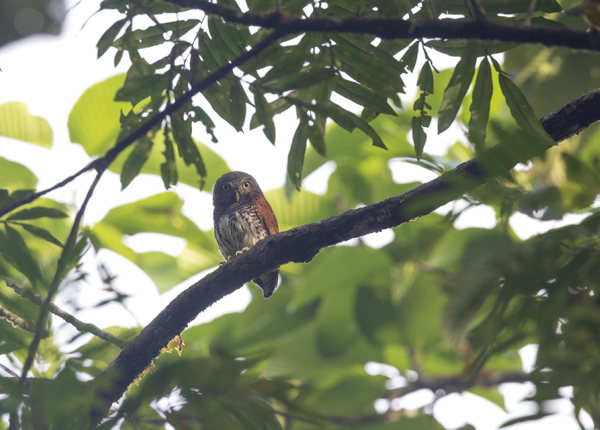Did You Know?
- Like the Serendib Scops Owl, the Chestnut-backed Owlet is endemic to Sri Lanka.
- This species is known to hunt and call frequently in the daytime.
How The Peregrine Fund is Helping
Though The Peregrine Fund doesn't work directly with Chestnut-backed Owlets, our efforts in scientific research, habitat conservation, education, and community development help conserve raptors on a global scale. We also supply literature to researchers from our avian research library, which helps scientists around the world gather and share important information on raptor conservation.
Where it Lives
This species is found in wet zone habitats of Sri Lanka. It is found lowland habitats to just below 2,000 meters above sea level. It is known to spend its time in the tops of tall trees, within the forest canopy.
Why it Needs our Help
This species is categorized as Near Threatened. Unfortunately, habitat loss and degradation are the biggest threat this species faces.
What it Eats
As you can imagine, a small owl will generally take relatively small prey. This owlet feeds on a number of different vertebrates and invertebrates including insects, frogs, geckos, lizards, mice, and small birds.
Nests, Eggs, and Young
Unfortunately, very little is known about the courtship, breeding, and nesting habits of this beautiful owl. Scientists know that it generally lays eggs sometime between March and May. Like other owls, it doesn't build its own nest, but rather places its eggs in tree cavities, or in nest holes made by other bird species, such as woodpeckers. The female will usually lay two eggs. Apart from this, not much else is known. How long do the young stay in the nest? How long will they stay with the adults after they fledge? Which parent does most of the incubating or do they share equally in this duty? There is so much more we need to learn about this species!
Chestnut-backed Owlet and the World Center for Birds of Prey
Though the Chestnut-backed Owlet lives far away from Boise, Idaho, you can still learn a lot about owls with a visit to our Velma Morrison Interpretive Center at The Peregrine Fund headquarters. The visitor center at our World Center for Birds of Preyincludes owls among its avian ambassadors, including an Eurasian Eagle Owl, a Verreaux's Eagle-owl and a Western Screech Owl. This is a great chance to see owls up close and learn about the wonderful and interesting adaptations they have in order to survive in their respective habitats. There is also a touch table with owl feathers and other natural objects available for exploration.
References:
Holt, D. W., R. Berkley, C. Deppe, P. L. Enríquez, J. L. Petersen, J. L. Rangel Salazar, K. P. Segars, K. L. Wood, A. Bonan, and J. S. Marks (2020). Chestnut-backed Owlet (Glaucidium castanotum), version 1.0. In Birds of the World (J. del Hoyo, A. Elliott, J. Sargatal, D. A. Christie, and E. de Juana, Editors). Cornell Lab of Ornithology, Ithaca, NY, USA. https://doi.org/10.2173/bow.chbowl1.01









